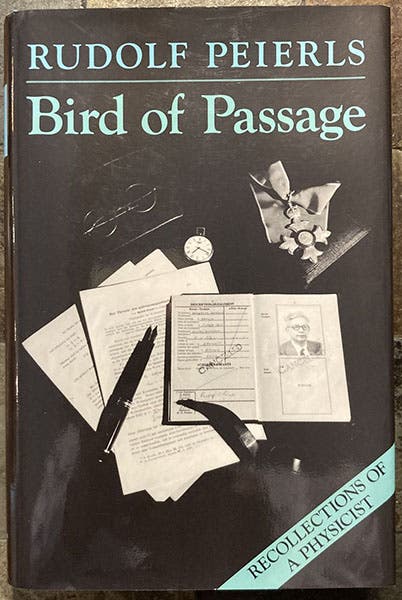Scientist of the Day - Rudolf Peierls
Rudolf Peierls, a German/Jewish/British physicist, died Sep. 19, 1995, at the age of 88. Born in Berlin, Peierls began his study of physics in Berlin, then moved to Munich to study with Arnold Sommerfeld, to Leipzig to work with Werner Heisenberg, and to Zurich to become an assistant to Wolfgang Pauli. There is nothing quite like learning quantum mechanics from three of the men who created the quantum revolution of the 1920s!
Peierls then went to study abroad in England, at Cambridge and Manchester, and while there, in 1933, Hitler had all Jews removed from academic positions in Germany, and Peierls wisely decided to stay in England. With the help of various British physicists, he was offered a professorship at Birmingham in 1937, where he would teach until 1964.
Peierls was joined at Birmingham in late 1939 by another refugee physicist, this one from Austria, Otto Frisch. Frisch was the nephew of physicist Lise Meitner, and he had been visiting his aunt in Sweden over the Christmas holidays of 1938, when Meitner got word from her colleague in Berlin, Otto Hahn, that he had bombarded uranium with neutrons and had somehow produced barium, a much lighter element. It was Meitner and Frisch (and not Hahn) who realized that Hahn had split the uranium atom, with barium as one of the byproducts. And it was Frisch who named the process fission and who realized that fission had the potential to produce prodigious amounts of energy that might be used for good or for not-so-good purposes.
Frisch was working in England in the fall of 1939, when war broke out between Germany and Great Britain, and so he stayed put, and was offered a position at Birmingham, joining Peierls. The two often wondered whether it might be possible to design and build a fission bomb, and if so, whether Germany might try to construct one. The general consensus among others was that it would take tons of uranium to produce a chain reaction, and since no one had tons of uranium, there was no danger of anyone building a bomb. But no one had crunched the numbers.
Peierls and Frisch decided to tackle the problem during the winter of 1940. They discovered that building a bomb using ordinary uranium, U238, was indeed prohibitive, but they wondered about inducing fission in U235, the lighter and scarcer isotope of uranium. Only 0.7 % of uranium is U235, but if you could somehow separate it out, they found that the critical mass for U235 – the amount you need to sustain a runaway reaction – was just one pound. Put two half-pound chunks of U235 together, and you could release the energy of thousands of tons of dynamite.
Both men were astonished by the results and knew that had to tell someone in power, and keep their results secret. So they sat down and wrote a short memorandum, now called the Frisch-Peierls Memorandum, in which they summarized their conclusions, outlined how to go about building such a weapon, and even predicted the results of using such a weapon, both short- and long-term. In hindsight, it is quite an amazing document. Peierls typed it up himself – they didn't want to trust using a secretary – and they didn't really know to whom they should give it. They chose their boss at Birmingham, Mark Oliphant, who relayed it to Henry Tizard. England already had a committee to investigate the possible use of atomic energy, which was about to disband, when the Frisch-Peierls Memorandum hit their doorstep. The committee was immediately reconstituted as the MAUD committee, and in August of 1940, Tizard was sent off to the United States to inform the Americans that they should be looking into building atomic weapons (and also telling them about radar). Soon, the Manhattan Project was born. Peierls and Frisch, both classified as enemy aliens, were initially kept in the dark about all this, but after a time they were invited onto a MAUD subcommittee, and both eventually joined the Manhattan Project and worked at Las Alamos.
The Frisch-Peierls Memorandum was in two parts, one general, one technically detailed, and only two copies of each part were typed up. One original part has been preserved at the Bodleian Library at Oxford (first image).
Peierls moved to a chair at Oxford in 1964 and remained there until retirement. He was very concerned about the dangers and misuse of atomic energy and was active in various groups of atomic scientists with similar concerns.

Dust jacket, Bird of Passage: Recollections of a Physicist, by Rudolf Peierls, Princeton Univ. Press, 1985 (author’s copy)
In addition to technical books, Peierls compiled a collection of reviews, obituaries, talks, and short pieces (like the Frisch-Peierls Memorandum), which was published just after his death as Atomic Histories (1997). Ordinarily, I really like books like this, with behind-the-scenes insights from an insider, but I did not find any of the pieces here very exciting or insightful. Many were simply too technical and dull. Freeman Dyson and Jeremy Bernstein were much better at this than Peierls. But Peierls had earlier published an autobiography, Bird of Passage: Recollections of a Physicist (Princeton, 1985; seventh image), and this book I do recommend, for it is well-written and even exciting, and here you will find insider's observations that should be of interest. Peierls’ account of the drafting and reception of the Frisch-Peierls Memorandum is especially worth reading.
William B. Ashworth, Jr., Consultant for the History of Science, Linda Hall Library and Associate Professor emeritus, Department of History, University of Missouri-Kansas City. Comments or corrections are welcome; please direct to ashworthw@umkc.edu.












